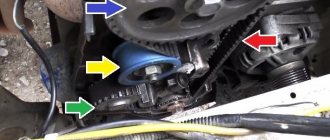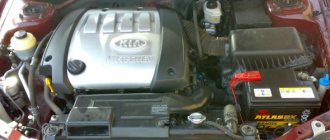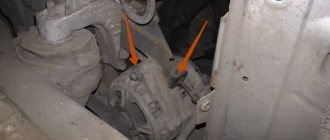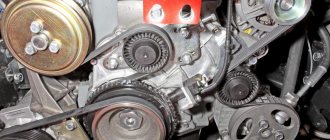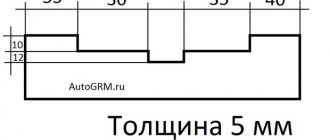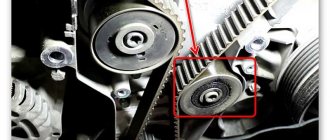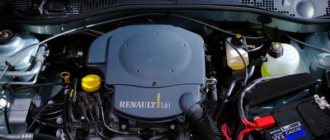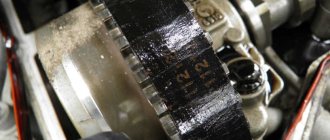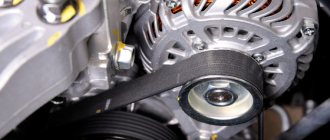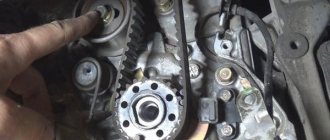Timely replacement of the timing belt on a Mitsubishi Lancer 9 with a 1.6 liter engine is one of the most important maintenance operations for the power unit of this vehicle.
The peculiarity of the model is that the engine here is “plug-in”. This term means that if the timing belt breaks, the pistons collide with the valves, causing the latter to bend.
Motors on which the valve bends are found on various brands and models of cars, including the Mitsubishi Lancer 9 with a 1.6-liter power unit, which will be discussed below.
Replacement frequency
In order to prevent the Lancer 9 from breaking the timing drive and subsequent serious and expensive repairs, the belt should be replaced every 90 thousand km (according to the recommendation of the car manufacturer). But in reality, it is better not to reach such a mileage and change the drive a little earlier - at 70-80 thousand km.
We also note that you should not rely on the high quality of the belt and be sure that it will serve the required period, and periodically inspect it.
Delamination, small cracks, severe wear of the teeth, traces of leaks of technical fluids on the drive surface are reasons for premature replacement, since a belt with such damage can break at any time.
Motor reliability
This unit does not have very good reliability indicators and requires special attention during the entire period of operation. Even cars that have just rolled off the production line are sometimes characterized by increased oil consumption in large quantities. Violation of regulated maintenance is guaranteed to lead to increased wear of the cylinder-piston group and other elements. In the future, this will lead to the following consequences: the appearance of oil in the spark plug wells, the piston rings may become stuck, and the connecting rod bearings and main bearings may rotate, since the engine oil is not distributed correctly due to wear of the cylinder-piston group.
The designers installed a chain in the gas distribution mechanism. This is a good solution because it gives greater reliability to the engine. The removal and installation of the timing chain must be carried out by highly qualified specialists, since incorrect installation of the chain can lead to serious problems, even to the point of requiring expensive engine repairs.
We select replacement parts
Along with the timing belt on the Mitsubishi Lancer 9 1.6, the tension roller must also be replaced, so you also need to purchase it. You can choose both original spare parts and their analogues.
Original for Lancer 9 are Mitsubishi belts with indexes MD342154 and 1145A051.
Analogs for them are consumables:
- Gates (5535XS);
- Contitech(CT1008);
- Sun (A343YU100).
As for the roller, the original spare part bears the Mitsubishi MD356509 index.
As an analogue, you can use NTN JPU57-008A-4 or NEP57008A6 rollers.
It is also worth noting one fact - the automaker Mitsubishi does not produce consumables - rollers and belts - on its own. Because of this, a situation often occurs that a car owner orders an original, and receives analogues - a Sun belt and an NTN roller.
In fact, these spare parts are original - they are what the automaker installs on engines from the factory, so it doesn’t make much sense to look for parts with only the Mitsubishi label, and you can safely install Sun and NTN products on your car.
Which product is better to supply?
In conclusion of the article, we note the most popular and reliable parts of the timing system that may need to be replaced. Only by choosing and purchasing high-quality spare parts for Lancer 9 can you guarantee long and reliable service for the car.
| Product, name | Name, catalog numbers |
| Original timing belts | Mitsubishi MD342154 and Mitsubishi 1145A051 |
| Analogs of belts | Gates 5535XS, Contitech CT1008 and SUN A343YU100 |
| Timing belt tensioner roller, original | Mitsubishi MD356509 |
| Analogs of rollers | NTN JPU 57-008 A-4, NTN NEP57008A6 and SUN A343YU100 |
| Original power steering belt (analogue) | Mitsubishi MD375935 (Gates 5PK 1063) |
| Original alternator belt (analogue) | Mitsubishi MN183019 (Gates 5PK903) |
Mitsubishi Lancer 9 timing kit
All the above parts are of very high quality and are used in almost all official Mitsubishi services in Russia and the CIS countries. They are guaranteed to ensure long and reliable service of the car engine. In general, replacing the timing belt of a Mitsubishi Lancer 9 is a simple task, but it does require some preparation and knowledge.
Source
What else can be changed together with the timing drive?
In the process of replacing the timing belt on a Mitsubishi Lancer 9 1.6, you have access to a number of other consumables and components, which allows you to change them at the same time, rather than dividing the work into two separate stages.
So, while servicing the timing drive, you can simultaneously replace:
- cooling system pump;
- drive belts for engine attachments (generator, power steering);
- crankshaft and camshaft oil seals;
- crankshaft sensor (if necessary).
But these elements can be replaced every second time when replacing the timing belt. That is, we install only a new timing belt and pulley once, and at the next replacement we also install the above-mentioned spare parts, and this is every 140 - 180 thousand km. mileage
The situation with the selection of attachment belts is the same as with the timing drive - there are both original consumables and their analogues.
Original consumables should be looked for by the following indices - Mitsubishi MD375935 (power steering) and MN183019 (generator).
As for analogues, for replacement you can purchase belts from two companies - Mitsuboshi (5PK1065 - power steering, 5PK905 - generator), and Gates (5PK1063 - power steering, 5PK903 - generator).
How to determine timing belt wear and when to change it?
Every driver should know that under no circumstances should the belt break. In this case, there will definitely be a meeting of the valves with the pistons, and this is a major overhaul, and therefore capital expenditure. Once a year it is necessary to carry out diagnostics of the timing belt assembly in general and the belt drive itself in particular. Periodic inspection will help identify defects at an early stage. The belt simply needs to be replaced if the following defects are present:
- the belt begins to crack;
- teeth show signs of wear;
- the ends are damp;
- the material has delaminated;
- Oil stains are visible on the surface of the belt.
In these cases, replacing the belt becomes a necessity. I would like to draw your attention to the presence of oil stains on the surface. This indicates that the seals also need to be replaced, since if this is not done, they will leak oil and it will begin to drip onto the new drive. And this will certainly lead to its premature destruction, since rubber is afraid of oil.
Someone turns to specialists to replace a belt, and they carry out professional repairs for a fee. Here we will talk about replacing the belt drive yourself. This option is most suitable for those who want to learn how to understand their car and not overpay for its repair. During the repair process, we will be required to disassemble the unit and then reassemble everything exactly. Some car enthusiasts install the crankshaft relative to the camshaft. If during the repair process they stand firm and do not move, this will mean that everything was done correctly. Many people do exactly this, but professionals do it differently: they install the shafts according to the marks they make. This way you can more accurately ensure that the crankshaft is installed correctly in relation to the camshaft.
If you install a belt with a slight misalignment of a couple of teeth, this will cause the engine to run unstably. A large displacement is not allowed at all, as this will lead to the pistons meeting the valves, and this will cause a major overhaul. Experts recommend replacing both the pump and the tension roller along with the belt. It is impossible to say for sure that the pump will have to be changed. The fact is that it is designed for 180,000 kilometers, that is, it can last twice as long as a belt drive. You don't need any special skills to do this job. You will only need to follow the instructions exactly and dismantle and install the parts in a certain sequence.
Tools
Replacing the timing belt on a 9th generation Mitsubishi Lancer with a 1.6 liter engine is an operation of average complexity, but it can be done in a garage.
To carry it out, you don’t need any special tools or devices; it’s enough to have:
- A set of open-end wrenches (required - 10, 12, 19);
- Set of heads and cranks with ratchet mechanism;
- Pliers;
- Rags;
- Marker (crayon);
- Jack;
- Time and patience.
To carry out the work, it is not necessary to have an inspection hole; everything can be done by placing the car on a flat area with a hard surface. It is also better to perform the replacement with an assistant:
About the car
The Mitsubishi Lancer 9 first rolled off the assembly line in 1973. At first there were 12 modifications with engine capacities from 1.2 to 1.6 liters. In the 70s, Lancer 9 was produced with a coupe body. Then the car began to be produced with four doors and engines of 1.6 and 1.8 liters.
Lancer 9 is the ninth generation and, under an agreement with Mitsubishi, it was produced in our country from 2007 to 2015. Over 8 years, 145 thousand copies of the model were sold in our country at a price starting at 760 thousand rubles.
The car is equipped with two versions of 16 valve engines:
- SOHC - one camshaft with valves is used (engines 4G13,4G18);
- DOHC - two camshafts are used (4G63 engine).
Work technology
Algorithm of actions:
- Remove the power steering drive belt. To do this, loosen 3 fastening bolts (you can get to two of them through the technological holes in the pulley), and then unscrew the adjusting bolt, after which the power steering pump will move, which will allow you to remove the belt;
- Jack up the front of the car on the right side (in the direction of travel), remove the wheel;
- Remove the protective cover on the fender liner to gain access to the crankshaft pulley;
- We dismantle the generator drive. Loosen the bolt securing the unit to the engine (located at the bottom of the generator) and the adjusting bolt lock. Then unscrew the adjusting bolt a little and remove it from the bracket. We feed the generator towards the engine and remove the belt;
- Unscrew the bolt securing the pulley to the pump and remove it;
- We dismantle the crankshaft pulley. To do this, ask the assistant to turn on the 5th gear at the gearbox and hold down the brake pedal, thus stopping the engine, which will allow you to tear off the pulley mounting bolt;
- Unscrew the 3 mounting bolts of the upper protective cover of the timing drive and remove it;
- We dismantle the lower timing cover by unscrewing its 5 fasteners;
- We set marks on the crankshaft and timing belt. To do this, turn on the 5th speed at the gearbox, put the wheel on the hub, and turning it, align the marks with the special ridges on the engine. We make sure that the marks on the knees and camshafts coincide with the sagging marks;
- Using pliers, remove the end of the roller tension spring from the groove and remove it. We unscrew the bolt securing the roller and dismantle it. After this, turning the crankshafts and timing gear is strictly prohibited, so as not to displace the marks;
- We install a stop (a wooden beam of suitable height) under the power unit;
- Unscrew the motor mount (mount). Moreover, you should unscrew its fasteners both to the body and to the engine. Remove the support;
- We unscrew the bolts of the jumper installed between the landing pad of the engine support and the power steering pump. Don’t forget to lubricate the contacts with graphite grease;
- Remove the timing belt;
- Install a new roller and secure it with a bolt;
- We put on a new belt, correctly placing it behind the roller;
- Install the tension spring.
After this, we check that the marks match correctly. To do this, after installing the new belt and tensioning it with a roller, turn on 5th gear again and install the wheel.
When turning the wheel, we make two revolutions of the crankshaft, align it with the mark and see if it coincides with the influx on the camshaft.
You can turn the gear off with the key.
If the location of the marks is not violated, we assemble the power unit in the reverse order. For convenience and correct assembly, it is advisable to mark some elements and parts with a marker or chalk during disassembly.
Mitsubishi Pajero timing mechanism drive
- Repair manuals
- Repair manual for Mitsubishi Pajero 1982-1998.
- Timing mechanism drive
3.5.9. Timing mechanism drive
Camshaft drive and high pressure fuel pump parts
| 1. Crankshaft pulley bolt 2. Special washer 3. Crankshaft pulley 4. Upper timing belt guard 5. Lower timing belt guard 6. Plug 7. Flange 8. Timing belt tension roller 9. Spacer 10. Spring toothed belt tensioner | 11. Toothed belt 12. Camshaft timing pulley 13. High pressure fuel pump timing belt pulley 14. Crankshaft timing pulley A = 80–90 Nm B = 22–30 Nm C = 170–190 Nm D = 65–75 Nm |
Lower timing belt drive parts
| 1. Flange 2. Spacer washer 3. Spacer 4. Toothed belt tensioner spring 5. Toothed belt tension roller 6. Lower toothed belt 7. Right compensating shaft drive gear | 8. Drive gear of the left compensation shaft 9. Spacer bushing 10. Crankshaft toothed pulley 11. Bolt, 34–60 Nm 12. Bolt, 34–40 Nm 13. Nut, 22–30 Nm |
Applying the lower timing belt (belt “B”)
| 1. Mark on the compensation shaft 2. Toothed belt tension roller | 3. Marks on the crankshaft timing pulley and on the compensation shaft 4. Toothed belt “B” 5. Crankshaft timing pulley |
Installing the timing belt tensioner
| 1, 2. Bolts |
To the tension of the timing belt
| 1. Belt tension side 2. Camshaft timing pulley 3. High pressure fuel pump drive gear 4. Timing belt tension roller 5. Belt tension side 6. Crankshaft timing pulley |
The figures below show the drive on a motor without compensation shafts. In the following description, the timing belt for driving the compensation shafts will be called the “B” belt. When describing, the starting point is that all timing drive parts have been removed and must be installed.
An alternative method for unscrewing the crankshaft pulley
One of the most difficult moments when disassembling an engine is unscrewing the crankshaft pulley fasteners. This bolt often “sticks” and is difficult to remove, and it is not always possible to do this by blocking the engine with the gearbox and brakes.
As an alternative to the above method of breaking the bolt, you can use a starter (although it is not advisable).
The technology for its implementation is as follows:
- Disconnect the wires from the ignition coils and injectors (so that the engine does not start while unscrewing the bolt);
- We put a long key on the bolt and, turning the crankshaft, bring the key so that it rests on the suspension arms or the ground;
- We get into the car and briefly (no more than 1 second) turn on the starter;
- After each switch-on, we check whether the bolt has been removed.
The power of the starter with a well-charged battery is quite enough to break the pulley bolt. But this method should be used only as a last resort if other methods have not brought results.
List of works during maintenance 1 (mileage 24 thousand km.)
- Changing the engine oil. Filling volume including engine filter. 1.5l - 4.2 liters, for dv. 2.0l is 4.3 liters. Price per 1l canister. Mobil 5W40 Super 3000 X1 - $7 (150012), cost of a 4 liter canister. — $27 (150013). You will also need an O-ring for the drain plug - $0.5 (MD050317).
- Replacing the oil filter. for 1.5l. price - $7 (MR984204), for 2.0 price - $7 (MD322508).
- Replacing the cabin filter. The price for an original carbon filter is $10 (7803A005).
- Checks during maintenance 1 and all subsequent ones:
- auxiliary drive belt;
- crankcase ventilation systems;
- hoses and connections of the cooling system;
- coolant;
- exhaust system;
- fuel lines and connections;
- covers for joints of different angular velocities;
- checking the technical condition of front suspension parts;
- checking the technical condition of rear suspension parts;
- tightening the threaded connections securing the chassis to the body;
- condition of tires and air pressure in them;
- wheel alignment angles;
- steering gear;
- power steering system;
- checking the free play (play) of the steering wheel;
- hydraulic brake pipelines and their connections;
- pads, discs and drums of wheel brake mechanisms;
- parking brake;
- air conditioner refrigerant
- brake fluid;
- accumulator battery;
- spark plug;
- headlight adjustment;
- locks, hinges, hood latch, lubrication of body fittings;
- cleaning drainage holes;
Mitsubishi Lancer X Megaladon 1.8 MT › Logbook › ✔Opening - Timing chain replacement⛓️ Lancer X
Hi all. Now the time has come to replace the chain. Why I was completely lost with the replacement is described in this article (Visit to a motor mechanic and a small rally), but when ordering a spare part there was a very unpleasant situation - they sent a fake chain, read more in this article (Timing chain on Lancer X. Is it all a scam or am I not understanding something? ). But let's not talk about sad things, in the end I was advised to have a good motor mechanic in my city (last time I went to the motor mechanic for diagnostics 50 km away). We met and got acquainted (his name is Alexey), I explained the situation, he said to buy another crankshaft oil seal and REINZOSIL sealant.
List of required spare parts for chain replacement:
New chain 1140A073
Calipers
MN183892 and MN183893
Tensioner
MN183894
Valve cover gasket VICTOR REINZ
715409200
Crankshaft oil seal
1052A809
Sealant REINZOSIL
703141420 A little more about the chain:
the quality of the chain appears to be good, MORSE is stamped on the links. Morse (aka BorgWarner Inc) is an American manufacturer and supplier of automotive components. It is known primarily for transmission systems, including manual and automatic transmissions and transmission parts (for example, electro-hydraulic components, gearbox control units, clutches), as well as turbochargers, timing components, and all-wheel drive systems. Info from this article
When the missing salaries arrived, I signed up for 11 am the next day. When I arrived “to warm up,” we measured the compression of cylinders 1 and 2 together, showed 12, 3.4 -12.5, at first we thought it was not enough, then it ran through the service program and it turned out that the compression was normal. By the way, the original spark plugs seem to be in satisfactory condition (I will change them anyway), but we were horrified by the gap, about 1.5 mm.
Since it was a working day, I was not able to be present during the replacement and Alexey kindly agreed to take a couple of photos when opening the engine. Leaving Lance with Alexei, I went to work and the painful wait began. Half a day without a car feels like prostration. I’m generally silent about the ride on the minibus, it caused a stupor; I had lost the habit of riding public transport, and I fully felt the expression without wheels as without legs. I didn’t want to call to distract the master, but there was only one thought in my head - at least some kind of jamb in the engine wouldn’t pop up.
In the evening, closer to the appointed time, I called Alexey, he reassured me - everything was normal. The replacement of the chain was successful, no varnish was found, there was no wear on the shafts, the valves at the inlet, on cylinders 1 and 2 were slightly jammed, but Alexey corrected this problem by sanding the cups.
We didn’t measure how long the old chain stretched, but we measured the length when folded; it was 56.5 for some reason, 1 cm less than my measurement for the new chain. Maybe the fact is that there are more links in the new one.
As a result, Lance began to work more quietly, the vibration practically disappeared, and I didn’t notice any significant changes in dynamics. The knocking that caused me to replace it turned out to be due to the oil; by the way, I used the original Engin Oil 5w40.
Maybe, of course, I got a handicraft, but I won’t pour the original anymore, I doubt they’ll take me. This original feels somewhat suspicious to the touch, not oily but soapy and too runny for 5w40. I have now ordered zic x9 5w40 from the official distributor, let’s see how it performs.
Selection of components
In addition to spare parts manufactured under the Mitsubishi brand, experts recommend the use of products from such brands.
- Hyundai/KIA. The products of this company are in no way inferior to the original, since the South Korean concern equips some of its car models with Mitsubishi engines produced under license.
- INA. A reputable German company supplies the market with high quality products at affordable prices. They are widely used not only in repair shops, but also on assembly lines.
- SKF. A well-known manufacturer of bearings from Sweden also produces sets of spare parts necessary for maintenance that do not raise any complaints.
- DAYCO. The once American, now international company has been present in the automotive components market since 1905. This is a reliable, time-tested supplier of spare parts.
- FEBI. Parts produced under this brand are supplied to the assembly shops of world-famous automakers. For example, such as Mercedes-Benz, DAF, BMW. They are also suitable for Mitsubishi Galant.
In addition to the timing belt and rollers, experts recommend changing the hydraulic tensioner. Remember that if difficulties arise with the gas distribution mechanism, the Mitsubishi Galant engine will suffer serious damage. You should not save money by purchasing spare parts of questionable quality.
Service should be trusted only to specialists from service centers with a proven reputation, and it is better, even when there is a good car service center nearby with reasonable prices, to prefer replacing timing components on a Mitsubishi Galant with your own hands. Independent work will allow you to:
- save money, and for owners of used cars, reducing repair costs is an important factor;
- get firm confidence that the procedure was performed correctly and you won’t have to wait for any unpleasant surprises.
However, it only makes sense to take on the task if you have certain technical skills!
Source
Timing marks 4G13/4G15
#1 kitzon
Users
25 messages
- Gender: Male
- Chelyabinsk city
- Realname: Ivan
- Make: Mitsubishi
- Model: Mirage
- Year: 2000
For a long time I sinned on the marks, since on my 4g13 engine the marks on the CV gear and cylinder head are in different places. And there are a lot of homemade marks stamped on my gear. I set the marks, the car drives, but I’m not sure that these are the marks that I need. I’m thinking of doing this: Set the KV pulley to 15 degrees. to TDC.
QIP Shot – Screen 026.jpeg35.19K QIP Shot – Screen 027.jpeg87.35K
Turn the kv counterclockwise up to 20 degrees. to TDC (approximately) we click the rocker (cam) there should be a gap, we begin to slowly scroll clockwise to 15 degrees before TDC and we understand that the gap is 15 degrees. before TDC converge to nothing. By this we understand that we have no violations in the timing belt, and the key on the Crankshaft gear is also in its place (not broken). Something like this)
#2 MTL
Users
222 messages
- Gender: Male
- Moscow city
- Realname: Vlad
- Make: BMW, Porsche
- Model: X5, Cayenne
- Engine: 3.0, 4.5T
- Year: 2001, 2003
#3 DVM
Users
2,900 messages
- Gender: Male
- City Novosibirsk
- Realname: Dmitry
- Brand: MMC Mirage Asti S
- Model: CJ2A
- Engine: 4G15 DOHC
- Year: 1998
If you are interested in the throttle and sensors, create a separate topic, name it correctly.
In the new topic, first, identify your car uniquely by VIN code or body number, to check it against the Mitsubishi catalogue.
in application to your car - there are engines that in a specific geographic market were installed on cars of a known generation. For example, what difference does it make to you what engines the cars were supplied with to Brazil or Australia?
read the Mitsubishi “Engine Workshop Manual 1990-2002” or “Service manual Engine” for specific engines.
returning to the original. I don’t know what’s different about your single internal combustion engine, only in the “Maintenance and Repair Manual”, publication code PWMR9511, everything is clear.
#4 DVM
Users
2,900 messages
- Gender: Male
- City Novosibirsk
- Realname: Dmitry
- Brand: MMC Mirage Asti S
- Model: CJ2A
- Engine: 4G15 DOHC
- Year: 1998
#5 Mtl
Users
222 messages
- Gender: Male
- Moscow city
- Realname: Vlad
- Make: BMW, Porsche
- Model: X5, Cayenne
- Engine: 3.0, 4.5T
- Year: 2001, 2003
7-9g, which is 14-18g across the knee.
Source
